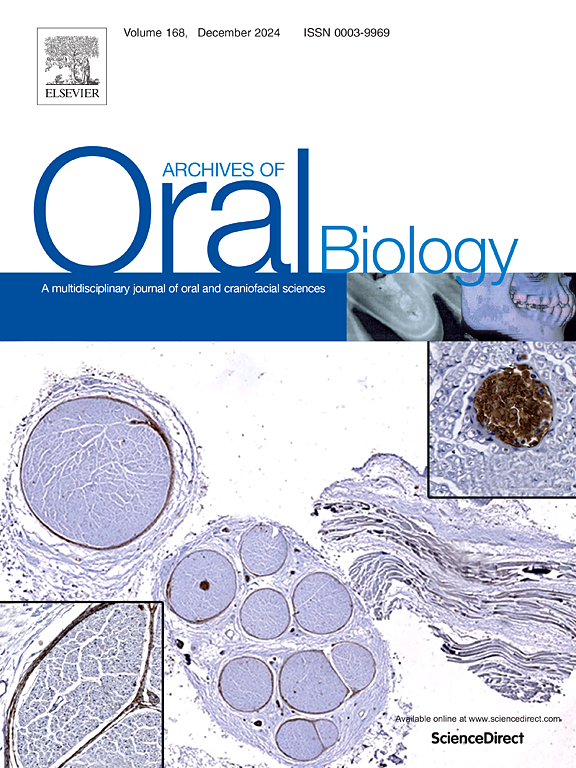锌- α -2糖蛋白在口腔鳞状细胞癌中的过表达及抗凋亡功能的维持
IF 2.1
4区 医学
Q2 DENTISTRY, ORAL SURGERY & MEDICINE
引用次数: 0
摘要
目的锌- α -2糖蛋白(ZAG)的过表达可被多种因素诱导,并有可能成为某些恶性肿瘤的生物标志物。然而,在口腔鳞状细胞癌(OSCC)中,与ZAG过表达相关的风险和影响仍然知之甚少。在此,我们研究了HPV16癌基因和槟榔碱对ZAG表达水平的影响以及ZAG在OSCC细胞系中可能的作用。设计检测无癌对照者口腔脱落细胞和OSCC口腔病变细胞中ZAG蛋白的表达水平。制备表达HPV16E6/E7并经槟榔碱处理的口腔细胞系,观察ZAG的表达。在ZAG过表达细胞和ZAG敲低细胞中检测ZAG对细胞生物活性的影响及其对UCP1的靶向作用。结果:与对照组相比,OSCC口腔病变细胞中ZAG蛋白的表达明显增加。值得注意的是,在HPV阳性的OSCC中,咀嚼槟榔液,以及这两种因素的组合中,ZAG的表达水平略高于无癌对照组。在HPV16癌蛋白E6和/或E7处理和槟榔碱(25 μg/ml)处理的口腔细胞中,ZAG表达上调。有趣的是,ZAG过表达显著增加UCP1和减少细胞凋亡,而在ZAG敲低的细胞中发现UCP1减少和细胞凋亡增加。TP53、STAT3、BCL2和NFKB1的mRNA表达水平与观察到的抗凋亡功能相对应。结论shpv癌蛋白和高剂量槟榔碱是OSCC中ZAG蛋白过表达的危险因素,ZAG蛋白具有抗凋亡功能。本文章由计算机程序翻译,如有差异,请以英文原文为准。
Zinc-alpha-2-glycoprotein overexpression and maintaining anti-apoptotic function in oral squamous cell carcinoma
Objective
Overexpression of zinc-alpha-2-glycoprotein (ZAG) can be induced by various factors and has potential to be a biomarker in certain malignancies. However, in oral squamous cell carcinoma (OSCC), the risks and effects associated with ZAG overexpression are still poorly known. Here, we investigated the effect of HPV16 oncogenes and arecoline on the expression levels of ZAG and the possible effects of ZAG in OSCC cell lines.
Design
The level of ZAG expression was determined in protein extracted from exfoliated buccal cells from cancer-free control individuals and oral lesion cells from OSCC. Oral cell lines expressing HPV16E6/E7, and treated with arecoline were prepared to investigate ZAG expression. The effects of ZAG on cell biological activity and its targeting of UCP1 were determined in ZAG-overexpressing and ZAG-knockdown cells. Results: The expression of ZAG protein was significantly increased in oral lesion cells from OSCC relative to controls. Notably, the expression level of ZAG in OSCC positive for HPV, betel-quid chewing, and combination of both factors, was slightly higher than in cancer-free controls. ZAG expression was upregulated in oral cells treated with HPV16 oncoproteins E6 and/or E7, and treatment with arecoline (25 μg/ml). Interestingly, ZAG overexpression significantly increased UCP1 and decreased apoptosis, whereas decreased UCP1 and increased apoptosis were found in ZAG-knockdown cells. The mRNA expression levels of TP53, STAT3, BCL2, and NFKB1 corresponded to observed anti-apoptosis function.
Conclusions
HPV oncoproteins and high doses of arecoline are risk factors for an overexpressed ZAG protein that has an anti-apoptotic function in OSCC.
求助全文
通过发布文献求助,成功后即可免费获取论文全文。
去求助
来源期刊

Archives of oral biology
医学-牙科与口腔外科
CiteScore
5.10
自引率
3.30%
发文量
177
审稿时长
26 days
期刊介绍:
Archives of Oral Biology is an international journal which aims to publish papers of the highest scientific quality in the oral and craniofacial sciences. The journal is particularly interested in research which advances knowledge in the mechanisms of craniofacial development and disease, including:
Cell and molecular biology
Molecular genetics
Immunology
Pathogenesis
Cellular microbiology
Embryology
Syndromology
Forensic dentistry
 求助内容:
求助内容: 应助结果提醒方式:
应助结果提醒方式:


